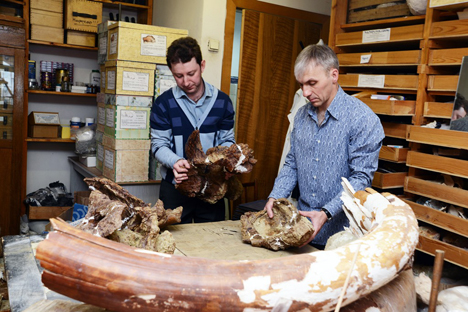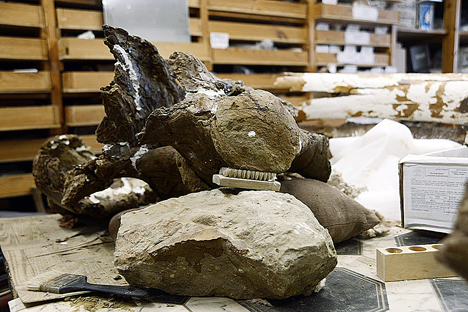New species of herbivorous dinosaur discovered in Siberia

The bones belonged to an adult titanosaur, a four-legged Saurischian dinosaur that lived from the Jurassic period and until the end of the Mesozoic era. Source: Press Photo
Scientists from Tomsk State University have found the remains of an ancient creature enclosed in blocks of stony rocks in southwestern Siberia. It took several years for paleontologists to free bone fragments from sandstone. However, when they were fully engaged in their work, the researchers realized that they had discovered a whole new species of dinosaur.
"We determined that we came across the remains of a very large herbivorous sauropod dinosaur belonging to the herbivorous Saurischian dinosaur (branch)," Tomsk State University researcher Stepan Ivantsov told RIR. "But only once we took out all the pieces, did it become clear that it was an entirely new species, previously unknown by scientists."
The bones belonged to an adult titanosaur, a four-legged Saurischian dinosaur that lived from the Jurassic period and until the end of the Mesozoic era.
The dinosaur, whose skeleton is being assembled by Tomsk palaeontologists, lived in the Late Cretaceous period about 100 million years ago. It was a large animal with a long neck and tail. The total length of the species could reach 30-40 meters and they weighed several dozen tons, growing steadily throughout their life.

The dinosaur lived in Siberia about 100 million years ago. Source: Press Photo
This discovery by Tomsk paleontologists is the first sauropod found on Russian territory. Now scientists at Tomsk State University will assemble the available fragments of the dinosaur into a single model. The largest bones that made up the titanosaur’s sacrum will soon be connected. In addition, parts of dinosaur shoulder and vertebrae have been assembled from multiple pieces.
"Seven years have passed since the discovery of the location of the dinosaur,” Ivantsov told RIR. “We were carefully removing bones from the rock all these years."
"The fragment 'ingrown' in sandstone initially weighed about 70 kilograms,” Ivantsov continued. “We have repeatedly found the remains of other animals – mammals, amphibians, lizards – close to the site where our titanosaur was discovered. This indicates that there was once an entire prehistoric ecosystem functioning here in southwest Siberia."
Next summer, these Tomsk paleontologists will continue to work on the "graveyard of dinosaurs," which is known in the scientific world as Shestakovsky Yar. More than half a century ago excavations and the search for the remains of ancient fauna were conducted near the village of Shestakovo in the Kuzbass region in south Siberia. Russia's largest dinosaur cemetery was discovered by scientists from Tomsk State University in 1953. Since then, fragments and whole skeletons of more than 500 species of prehistoric animals have been found.
All rights reserved by Rossiyskaya Gazeta.
Subscribe
to our newsletter!
Get the week's best stories straight to your inbox